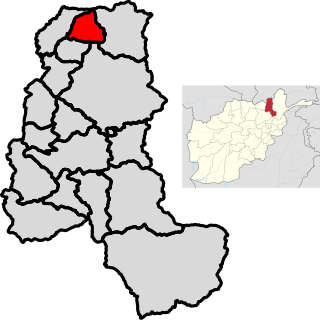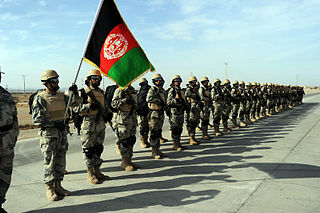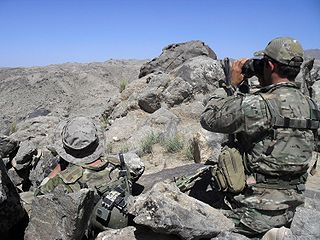
Helmand, also known as Hillmand, in ancient times, as Hermand and Hethumand, is one of the 34 provinces of Afghanistan, in the south of the country. It is the largest province by area, covering 58,584 square kilometres (20,000 sq mi) area. The province contains 18 districts, encompassing over 1,000 villages, and roughly 1,446,230 settled people. Lashkargah serves as the provincial capital. Helmand was part of the Greater Kandahar region until made into a separate province by the Afghan government in the 20th century.

Logar is one of the 34 provinces of Afghanistan located in the eastern section of the country. It is divided into 7 districts and contains hundreds of villages. Puli Alam is the capital of the province. As of 2021, Logar has a population of approximately 442,037 people, most of whom are ethnic Pashtuns and Tajiks.

Sar-e Pol, also spelled Sari Pul, is one of the thirty-four provinces of Afghanistan, located in the north of the country. It borders Ghor and Bamyan to the south, Samangan to the east, Balkh and Jowzjan to the north, and Faryab to the west. The province is divided into 7 districts and contains 896 villages. It has a population of about 632,000, which is multi-ethnic and mostly a tribal society. The province was created in 1988, with the support of northern Afghan politician Sayed Nasim Mihanparast. The city of Sar-e Pol serves as the provincial capital.

Maidan Wardak or Maidan, also called Wardag or Wardak, is one of the 34 provinces of Afghanistan, located in the central region of Afghanistan. It is divided into eight districts and has a population of approximately 500,000. The capital of the province is Maidan Shar, while the most populous district in the province is Saydabad District. Wardak is known for one of its famous high peak mountain known as.

The Taliban insurgency began after the group's fall from power during the 2001 War in Afghanistan. The Taliban forces fought against the Afghan government, led by President Hamid Karzai, and later by President Ashraf Ghani, and against a US-led coalition of forces that has included all members of NATO; the 2021 Taliban offensive resulted in the collapse of the government of Ashraf Ghani. The private sector in Pakistan extends financial aid to the Taliban, contributing to their financial sustenance.
Bala murghab is a district situated in the northeast of Badghis Province, Afghanistan. The district capital is Bala Murghab city which is located along the Murghab River. Bala Murghab is surrounded by some other important districts such as Ab Kamari, Muqur, Jawand, and Qadis.

Washir is a district in the west of Helmand Province, Afghanistan. Its population was reported in 2012 as 15,200, from the Pashtun ethnic group believed to be of Noorzai tribe. The district centre is the village of Washir. The district of Washer borders Farah province to the north and is 80 kilometres south of Lashkar Gah.
Waghaz is a district in Ghazni province, Afghanistan. It was formed in 2005 from part of Muqur District, and has a population estimated at 27,900.
Chārdara District is one of the seven districts in Kunduz Province in northern Afghanistan. It is situated in the south-west part of Kunduz Province and has borders with Qalay-I-Zal District to the north-west, Kunduz District to the north-east, Ali Abad District to the south-east, Baghlan Province to the south and Samangan Province to the south-west.

Yangi Qala District is a district in Takhar Province, Afghanistan. Economically the population of this district is primarily involved in agriculture. The main crops are rice and wheat, and the surplus rice is exporting to neighboring districts and provinces. There are 64 villages in the district. As of August 2021, the Taliban has full control over this district.

The War in Afghanistan was an armed conflict from 2001 to 2021. It was the direct response to the September 11 attacks. It began when an international military coalition led by the United States launched an invasion of Afghanistan, declaring Operation Enduring Freedom as part of the earlier-declared war on terror; toppling the Taliban-ruled Islamic Emirate and establishing the Islamic Republic three years later. The Taliban and its allies were expelled from major population centers by the US-led forces, supporting the anti-Taliban Northern Alliance; however Bin Laden relocated to neighboring Pakistan. The conflict officially ended with the 2021 Taliban offensive, which overthrew the Islamic Republic, and re-established the Islamic Emirate. It was the longest war in the military history of the United States, surpassing the length of the Vietnam War (1955–1975) by approximately 6 months.

The Afghan Border Force (ABF) was responsible for security of Afghanistan's border area with neighboring countries extending up to 30 miles (48 km) into the interior and formed part of the Afghan National Army. In December 2017, most of the Afghan Border Police (ABP) personnel of the Afghan National Police were transferred to the Afghan National Army to form the Afghan Border Force. The ABP retained 4,000 personnel for customs operations at border crossings and international airports such as checking documents of foreigners entering the country or deporting them.

The Shah Wali Kot Offensive was a five-day joint operation during the War in Afghanistan, conducted by Australian special forces and the Afghan National Army with US air support, between 10 and 14 June 2010. The operation took place in the Shah Wali Kot District of Kandahar Province, occurring in preparation for the coalition clearance of the province and resulting in heavy insurgent casualties.
The following lists events that happened during 2016 in Afghanistan.
The Nangarhar offensive was a 21-day military offensive in February and March 2016, carried out by the Afghan government against the Islamic State of Iraq and the Levant – Khorasan Province (ISIS–K), with the assistance of ISAF and U.S airstrikes. When the offensive ended, ISIS had reportedly lost all of its territory in Afghanistan and had been expelled from the country.

Operation Omari, also called the Spring Offensive, was an offensive launched by the Taliban against the Afghan government in Afghanistan. Its start was announced on 12 April 2016. The Taliban made their yearly spring offensive announcement on April 12, 2016. They named the offensive in honor of the movement's late leader. The announcement of Operation Omari includes details on how the members of the group should present themselves in public. The aim of the Operation is considered ambitious and its focus is on clearing the remaining areas from enemy control and presence. Unlike offensive announcements from previous years this announcement contained details about specific targets that would be attacked during the operation. The targets were stated in general terms with reference only to "large scale attacks on enemy positions across the country, martyrdom-seeking and tactical attacks against enemy strongholds, and assassination of enemy commanders in urban centers."
Events in the year 2017 in Afghanistan.
Events in the year 2018 in Afghanistan.
Events from the year 2019 in Afghanistan.
This article summarizes the history of the War in Afghanistan (2001–2021).












